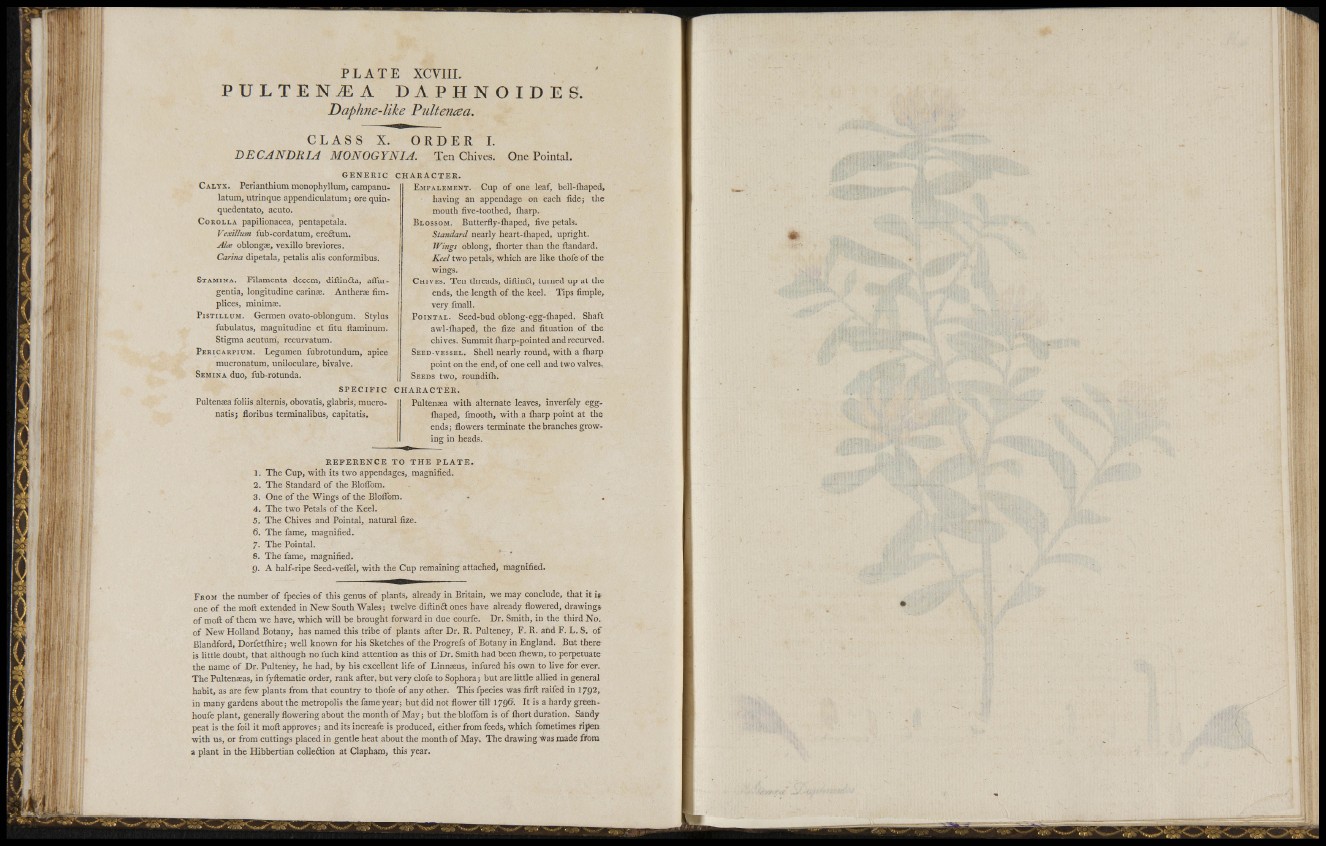
í.j n ;! R^IL! :Í
f1 ! •i l'i-vi-.'
^ ( f i ' i t i rf
á i i i ^ i
• •-É v»™;'
m i l k IP
L A T E XCVIIL
P U L T E N ^ A DAPHNOIDES.
DapJme-like Pulte?iaa.
C L A S S X. ORDER I.
BECANDRIA MONOGYNIA. Ten Chives. One Pointai.
G E N E E I C
CALYX. Periantlilum monophyllum, campanulatum,
utrinque appendiculatum; ore quinquedentato,
acuto.
COKOLLA papilionacea, pentapetala.
Vexillum fub-cordatum, ere£lum.
Alec oblongae, vexillo breviores.
Carina dipelala, petalis alls conformibus.
STAMINA. Filamenta decern, diflintìa, aflurgentia,
longitudine carin^e. Antheras fimpHces,
minimaa.
PisTiLLUM. Gerraen ovato-oblongum. Stylus
fubulatus, magnitudine et fitu Itaminum.
Stigma acutuni, recurvatum.
P E R I C A R P I U M . Legumen fubrotundum, apice
mucronatum, uniloculare, bivalve.
SEMINA duo, fub-rotunda.
S P E C I F I C
Fultensea foliis alternis, obovatis, glabris, mucronatis;
floribus terminalibus, capitatis.
C H A E A C T E E .
EMPALEMENT. Cup of one leaf, bell-iliaped,
having an appendage on each fide; the
mouth five-toothed, fliarp.
BLOSSOM. Butterfly-fliaped, five petals.
Sianilard nearly heart-lhaped, upright.
JFiTigs oblong, fliorter than the ftandard.
Kce/ two petals, which are like thofe of Uie
wings.
CHIVES. Ten threads, diftinft, turned up at the
ends, tlie length of die keel. Tips fimple,
very fmall.
P o i N T A L . Seed-bud oblong-egg-lliaped. Shaft
awl-ihaped, the fize and fituation of the
chives. Summit iliarp-pointed and recurved.
SEED-VESSEL. Shell nearly round, with a fliarp
point on the end, of one cell and two valves.
SEEDS two, roundiih.
C H A E A C T E E .
Pultenasa with alternate leaves, inverfely eggfliaped,
fmooth, with a iharp point at the
ends; flowers terminate the branches growing
in heads.
E E F E E E N C E TO T H E PLATE.
1. The Cup, with its two appendages, magnified.
2. The Standard of the Bloflbm.
3. One of the Wings of the Bloflbm.
4. The two Petals of the Keel.
5. The Chives and Pointal, natural fize.
6. The fame, magnified.
7. The Pointal.
8. The fame, magnified.
g. A half-ripe Seed-veflfel, with the Cup remaining attached, magnified.
FROM the number of fpecies of this genus of plants, already in Britain, we may conclude, that it is
one of the moft extended in New South Wales; twelve diftinft ones have already flowered, drawings
of mofl: of them w-e have, which will be brought forward in due courfe. Dr. Smith, in the third No.
of New Holland Botany, has named this tribe of plants after Dr. R, Palteney, F. R. and F. L. S. of
Blandford, Dorfetfliire; well known for his Sketches of the Progrefs of Botany in England. But there
is little doubt, that although no fuch kind attention as this of Dr. Smith had been fliewn, to perpetuate
the name of Dr. Pulteney, he had, by his excellent life of Linnaeus, infured his own to live for ever.
The Pultenaeas, in fyflematic order, rank after, but very clofe to Sophora; but are little allied in general
habit, as are few plants from that country to thofe of any other. This fpecies was firit raifed in 1702,
in many gardens about the metropolis the fame year; but did not flower till 179&. It is ahardygreenhoufe
plant, generally flowering about the month of May; but the bloflbm is of fliort duration. Sandy
peat is the foil it mofl; approves; and its increafe is produced, either from feeds, which fometimes ripen
with us, or from cuttings placed in gentle heat about the month of May, The drawing Was made from
a plant in the Hibbertian colledtion at Clapham, this year.